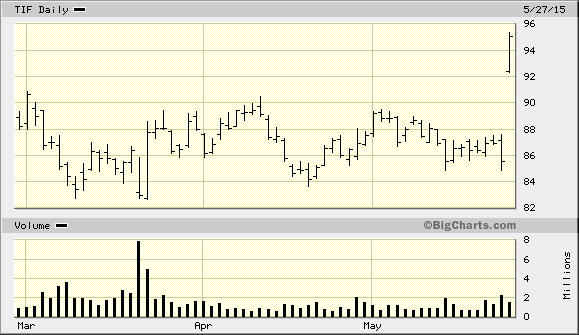After spending all of 2015 year to date in a dull trading range, shares of Tiffany & Co. (NYSE:TIF) were sparkling this week on the back of a better-than-expected earnings release.
So, with the market now trading sideways and investors getting skittish, might TIF stock be a diamond in the rough?
Let’s take a look.
Tiffany & Co.’s results look a lot less glittering and fabulous when you dig into the numbers. Total sales were actually down 5% in the quarter ended April 30, pulled lower by weak overseas sales, particularly in Japan. And earnings per share dropped 16%, from $0.97 to $0.81.
So, if sales and earnings were both down, what explains investor enthusiasm for TIF stock this morning?
I have two words for you: expectations and comps.
We’ll start with expectations. Tiffany & Co. set the bar very low going into this release. In March, TIF said that it expected revenues to be down by as much as 10%. So being down “only” 5% looks fantastic by comparison.
Tiffany & Co. actually had a respectable quarter in the Americas and Europe, where sales were up 1% and 2%, respectively, over the same quarter last year. Excluding the effects of a strong dollar, European sales were actually up 21% and same-store sales were up 17%. For a continent that is still struggling to shake off the effects of its worst recession since the 1930s, that’s nothing short of amazing.
It’s in Japan that the numbers start to look ugly. Total sales were down 30%, due in part to the collapsing value of the yen. But even excluding currency effects, Japanese sales were down 18%. Same-store sales were down 24%.
This is where the comps come into play. The Japanese numbers look particularly bad because they are being compared to artificially high numbers from the previous year. Japanese consumers went on a spending binge in the first quarter of last year in anticipation of Shinzo Abe’s sales tax hike. On April 1 of last year, the Japanese sales tax rate jumped from 5% to 8%, so Japanese shoppers took a “now or never” approach to high-end shopping. Spending fell off a cliff in the quarters that followed, so Tiffany & Co.’s Japanese comps should look a lot better next quarter.
So, what are the takeaways here?
The good news is that European luxury shoppers are opening their wallets again and that the worst damage has already been done to Japanese sales. The bad news -- for Tiffany & Co and for American luxury retailers in general -- is that the strong dollar is a major headwind.
A little over half of Tiffany’s reported sales come from overseas, but the number is actually a lot higher than that. Foreign tourists make up a high but hard-to-quantify percentage of domestic U.S. sales, particularly in the flagship New York store of Breakfast at Tiffany’s fame.
In a roaring market for luxury goods, the effects of a strong dollar could be overcome by even stronger foreign sales. But that’s not our situation today. Japan is still limping along, and China’s growth is slowing. It also doesn’t help that conspicuous consumption is passé in China after the government’s crackdown on bribery and gift giving.
So, Tiffany & Co. and its peers will be operating in a very difficult environment for as long as the dollar remains strong.
What about TIF stock? Tiffany is an iconic brand and a wildly profitably company. But with shares fetching 25 times trailing earnings and 20 times next year’s expected earnings, the stock is by no means a screaming bargain. On a good pullback, TIF stock is worth considering. But for now, it might be best to leave it in its pretty blue box.
Disclosures: None
Charles Lewis Sizemore, CFA, is chief investment officer of the investment firm Sizemore Capital Management and the author of the Sizemore Insights blog.

